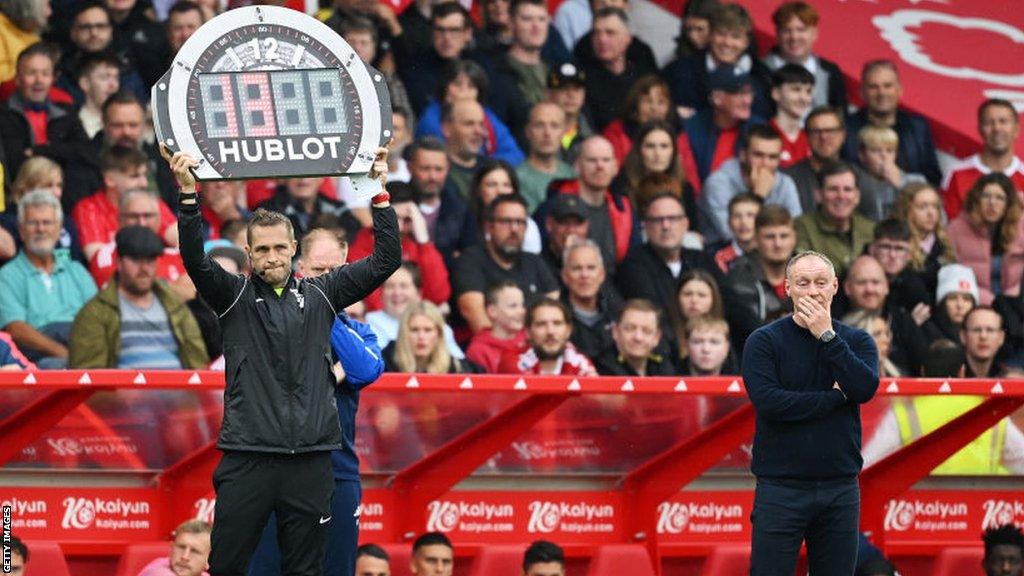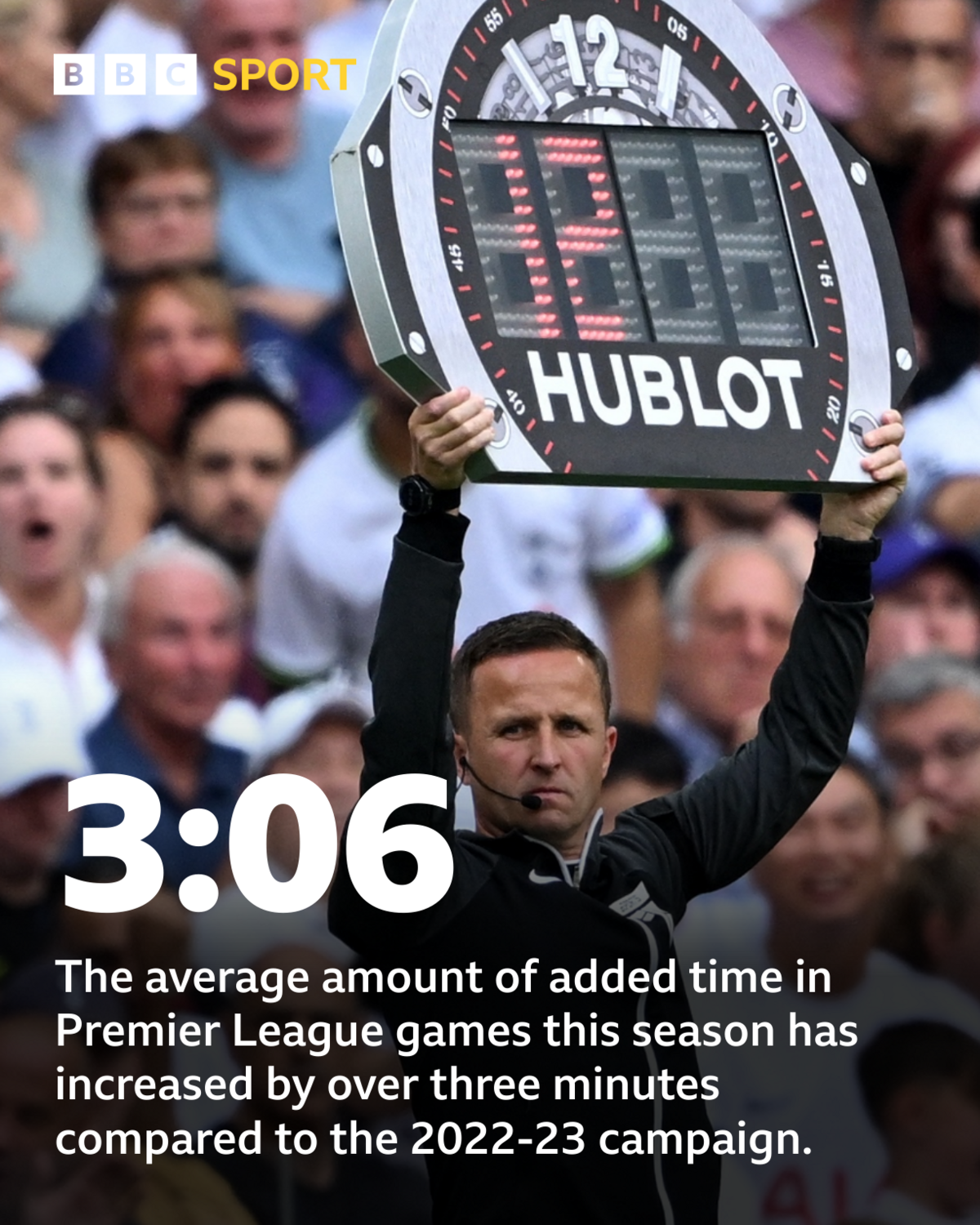Premier League: What impact has longer added time had on matches?
- Published
- comments

Have longer games led to more late drama in the Premier League?
Over the opening eight weeks of the Premier League's 2023-24 season one of the main talking points has been the amount of added time in matches.
England's refereeing body the PGMOL is using longer amounts of stoppage time this season as part of a directive from Ifab, football's lawmakers, in a move aimed at tackling time-wasting.
That has resulted in top-flight matches, on average, running beyond 100 minutes.
But the new rules have been described by some as "absurd" and they have not been adopted in European competitions, with some players criticising the move on welfare grounds.
So, with eight gameweeks completed, what effect have they had on the Premier League?
Just how much longer are matches?
Long periods of extra time were first seen at the men's World Cup in Qatar last year.
That led to previously unheard of amounts of added time and some of the longest games in the tournament's history - with more than 27 minutes added on to England's match against Iran in the most extreme case.
In the eight matchdays, or 80 matches, since that policy was implemented in the Premier League at the start of this season, the average amount of added time in games stands at 11 minutes 33 seconds.
As you would expect, that is an increase on the 2022-23 average, which was eight minutes 27 seconds.
The longest game so far was Fulham's 3-1 victory over Sheffield United. That match finished after 113 minutes 54 seconds - although it was overshadowed by a serious injury to Blades defender Chris Basham.

Premier League matches are lasting for an average match length of 101 minutes and 33 seconds this season
Do longer matches mean more action?
One of the main driving forces of the clampdown on time wasting was the aim of ensuring the ball remains in play for longer.
Last year, former referee Mark Clattenburg even suggested introducing 60-minute matches with a stop-clock to eradicate gamesmanship.
The figures, certainly as far as the Premier League is concerned, supported the idea.
In last season's competition, the average 'ball in play' time was 54 minutes 52 seconds - the lowest in more than a decade.
Has the stricter approach had the desired affect?
Well, so far, the evidence suggests it has, with Premier League matches seeing an average ball-in-play time of 58 minutes 48 seconds - an increase of almost four minutes.
Premier League's longest matches 2023-24 | Time |
|---|---|
07/10/23: Fulham 3-1 Sheffield United | 113:54 |
16/09/23: Aston Villa 3-1 Crystal Palace | 112:02 |
16/09/23: Tottenham 2-1 Sheffield United | 109:15 |
20/08/23: Aston Villa 4-0 Everton | 108:03 |
12/08/23: Newcastle 5-1 Aston Villa | 107:39 |
Have we seen more late drama?
More added time means more opportunity for late drama - and we have witnessed exactly that so far in the 2023-24 Premier League.
There have been a total of 32 injury time goals scored already this season - that is across both the first and second halves of matches - which accounts for 13.3% of the total number.
For comparison, there had been just 11 injury time goals scored after eight matchdays last season.
There were 84 injury time goals scored across the entire 2022-23 campaign - with that figure representing 7.7% of the total goals scored.
We have seen three of the five latest goals in Premier League history, with Arsenal's Gabriel Jesus (100:15), Aston Villa's Leon Bailey (100:09) and Tottenham's Dejan Kulusevski (99:53) all scoring deep into added time since August.
New timewasting rules are 'putting more pressure on referees'
Do the changes favour 'bigger' clubs?
The introduction of the five substitute rule last season was one which Everton manager Sean Dyche said he believed would benefit bigger clubs, because of their ability to assemble stronger squads.
But, combined with the increased added time this campaign, does the data support that view?
The number of injury time goals in the second half of matches stands at 24 this season - which, with 30 matchdays remaining, is already almost half the total scored in the whole of last season (49).
This is a significant increase on this stage last season, when only five goals had been scored in second-half injury time.
But an overall trend is yet to emerge.
Joint league leaders Arsenal and Tottenham, along with Aston Villa, lead the way for second half added time goals this term, with three each.
They are followed by Manchester United, Newcastle United and Liverpool - who like Arsenal all finished in last season's top five - and Brentford, each on two. A total of 14 of the 20 clubs have at least one.
Only eight matchdays in, there is time for different patterns to emerge. But, with an average of more than three minutes extra stoppage time per fixture, leading to a total amount of added time per matchday of close to two hours, it is clear the new rules have had a significant impact.
Premier League matchday | Number of fixtures | Total added time | Cards for time wasting |
|---|---|---|---|
1 | 10 | 1h 55m 12s | 6 |
2 | 9 | 1h 49m 28s | 8 |
3 | 10 | 1h 44m 49s | 5 |
4 | 10 | 1h 55m 59s | 5 |
5 | 10 | 2h 6m 44s | 9 |
6 | 10 | 1h 51m 21s | 3 |
7 | 11 | 2h 8m 27s | 14 |
8 | 10 | 1h 52m 33s | 4 |
BBC Sport app: Download to follow all the latest on your Premier League team

Our coverage of your Premier League club is bigger and better than ever before - follow your team and sign up for notifications in the BBC Sport app to make sure you never miss a moment
